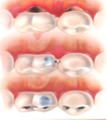Holes in your teeth, and where they come from
Have you ever thought of a family that won't get holes in their teeth? Can you imagine life with no fillings and no dental bills to make you grumble? Do you think that’s even possible?
Yes, you can prevent all cavities in your family!
Allow us to explain what modern research has shown us in the last couple of years.
We have around 300 different types of bacteria in our mouths. 98% of these are harmless to us. In fact, we need them there to eat the foods that the bad bacteria need. Two specific types, however — Streptococcus mutans and Lactobacillus — produce much more acid than all of the others together. They can live in acid that would kill other organisms and therefore survive in extreme conditions. The mouth turns more and more acidic and reduce the ‘good’ bacteria. This causes nearly all cavities.
That is all old news. So what is new?
Research has proven the following:
- Patients with many holes and fillings always had more than 1 million Streptococcus mutans and Lactobacillus bacteria in each millilitre of saliva.
- These patients always ate or drank 3 times or more sugar or fruity acid-containing foods or drinks between their main meals.
- Streptococcus mutans only really grow after not cleaning for 24 hours.
- Lactobacillus need a constant supply of sugars and die if one does not eat sugars for a week.
- Brushing and flossing alone cannot eliminate Streptococcus mutans forever (it only reduces them).
- Children become infected at about 18-24 months old through kissing, cuddling and feeding.
- If children eat properly when they are young, Streptococcus mutans do die, however it is likely they will become re-infected through familial interactions.
- The more Streptococcus mutans parents have in their saliva, the likelier it is they could pass this infection on to their children.
- Dental burs, fillings, and scaling instruments alone cannot eradicate Streptococcus mutans and therefore cannot stop holes in your teeth. Dentists cannot prevent cavities, but you can!
- Streptococcus mutans can only be killed by specific anti-bacterial agents in toothpastes and by eating properly.
- Dental caries are the result of a juvenile, transferable, diet related bacterial disease that get passed on from one person to the next.
- This infection can be cured and new caries can be prevented.
The following program will reduce the harmful Streptococcus mutans to harmless levels. Treatment for the whole family!
What you can do to stop this disease
Remove all plaque properly at least once a day. The best time is in the evening. Bacteria need 30-36 hours to grow and therefore brushing once a day is usually enough. Use a toothbrush and floss at night. If food remains in your mouth overnight it causes a lot of bacterial growth and acid formation. In children, you can colour plaque with food colouring or disclosing tablets once in a while before brushing to identify problem areas. Brush the tongue from back to front. While once a day is usually enough, we believe it is better to brush twice a day.
Remember the important areas on your teeth.

- Just above the gumline: Reach with an angled toothbrush.
- Between the teeth: Reach with dental floss only.
- On the surface of your tooth: Reach with toothbrush.
Brush with any toothpaste you like. Most modern toothpastes are very good. If you have teeth very sensitive to hot or cold, try a brand like Sensodyne, Mentadent-S, Colgate Desens, Oral-B Desens, etc. In the morning you may brush very lightly and/or just rinse your mouth with a mouth rinse product like Dentyl. This is really just for your heart and your soul, and to have fresh breath. Ideally we recommend you to brush twice per day.
In some instances you may brush with Elugel toothpaste for a limited period. Elugel contains chlorhexidine which kills Streptococcus mutans, Lactobacillus and other harmful bacteria.
- Brush with Elugel morning and evening for 5 to 7 days.
- Then only use Elugel morning and evening twice a week, using normal toothpaste at other times.
Limit the intake (even in small amounts) of sugar-containing fluids and solids between meals to a minimum. The same applies to fruit acid (whole fruit and fruit juices) taken between meals. People who consume sugars and acids during meals are at much lower risk of dental decay.
Report back every 4 to 6 months according to the treatment plan arranged with your dentist. A plaque removal and fluoride treatment regimen may be essential for all people at higher risk of caries.
Good luck and remember that you are now in control of your teeth!








